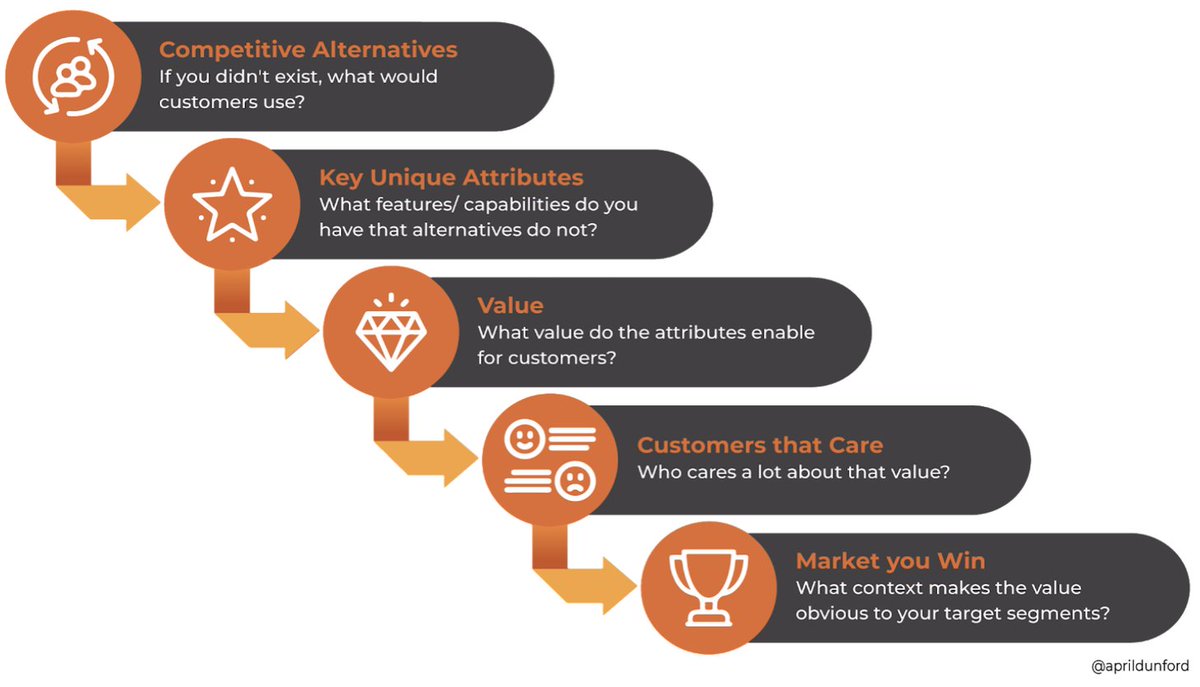This week: A quickstart guide to positioning, brought to you by the one and only @aprildunford.
This is the most succinct and practical guide to nailing your product’s positioning you'll find.
Takeaways in thread https://www.lennysnewsletter.com/p/positioning
https://www.lennysnewsletter.com/p/positioning
This is the most succinct and practical guide to nailing your product’s positioning you'll find.
Takeaways in thread
 https://www.lennysnewsletter.com/p/positioning
https://www.lennysnewsletter.com/p/positioning
1/ What is "Positioning"?
Positioning defines how your product is a leader at delivering something that a well-defined set of customers cares a lot about.
Positioning defines how your product is a leader at delivering something that a well-defined set of customers cares a lot about.
2/ Put another way, positioning is like context-setting for products. It’s a bit like the opening scene of a movie. The opening scene gets us oriented. It answers the big questions: Where are we? What year is this? What’s happening? How should I feel? Who are these people?
3/ Good positioning sets off a set of assumptions about your product that are true. Bad positioning sets off a set of assumptions about your product that aren't true - leaving your sales and marketing teams to do the work of undoing the damage your positioning has already done.
4/ For many people, positioning was taught to them in school using "The Positioning Statement." It's a sort of "Mad Libs" fill in the blanks exercise. The blanks are things like market category, value, competitors, etc. Typically it looks something like this.
5/ This exercise is not only pointless but potentially dangerous. It assumes that there is only one answer for each of the blanks, and you “know” what it is. Most products can be positioned in multiple categories, with different competitors, with different value, etc.
6/ A better approach is to think of positioning as five distinct components, whose relationship to each other create the magic:
1. Competitive Alternatives
2. Differentiated “Features” or “Capabilities”
3. Value for customers
4. Target Customer Segmentation
5. Market Category
1. Competitive Alternatives
2. Differentiated “Features” or “Capabilities”
3. Value for customers
4. Target Customer Segmentation
5. Market Category
7/ We start with Competitive Alternatives, or what would customers do if our solution didn’t exist.
Once we have that, we can ask ourselves, “What do we have that the alternatives do not?” That gives us a list of Differentiated features or Key Unique Attributes.
Once we have that, we can ask ourselves, “What do we have that the alternatives do not?” That gives us a list of Differentiated features or Key Unique Attributes.
8/ We can then go down that list and ask ourselves, “So what for customers?”
Put another way, what is the Value those capabilities enable for our buyers?
Put another way, what is the Value those capabilities enable for our buyers?
9/ Once we understand what our differentiated value is, then we can move to customer segmentation, or who are the Customers that Care a lot about our value.
10/ There is likely a wide range of buyers that care about that value, but certain customers care much more than others. What are the characteristics of a customer that makes them care a lot about your differentiated value? That gives us an idea of who our best-fit customers are.
11/ Lastly, we move to Market Category. Our best market category is the context we position our product in such that our value is obvious to our target customers. Put another way, it is the definition of the Market we Intend to Win.
12/ Once you understand the flow, conceptually, it's pretty easy. But that doesn't mean there aren't a lot of ways you can mess this process up. Here are the three most common traps:
13/ Trap 1: Defining competitive alternatives as any possible competitor.
Trap 2: Creating “phantom competitors”
Trap 3:Assuming that you have to create a new market category to grow
Trap 2: Creating “phantom competitors”
Trap 3:Assuming that you have to create a new market category to grow
14/ For much more, including a lot more examples and in-depth advice, don't miss the full post.
And again, thank you to @aprildunford for dropping so much wisdom https://www.lennysnewsletter.com/p/positioning
https://www.lennysnewsletter.com/p/positioning
And again, thank you to @aprildunford for dropping so much wisdom
 https://www.lennysnewsletter.com/p/positioning
https://www.lennysnewsletter.com/p/positioning

 Read on Twitter
Read on Twitter



